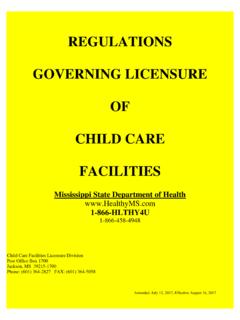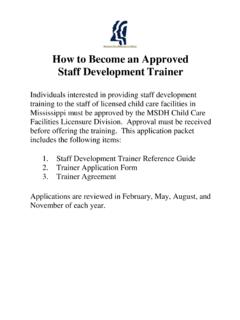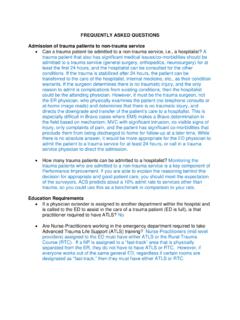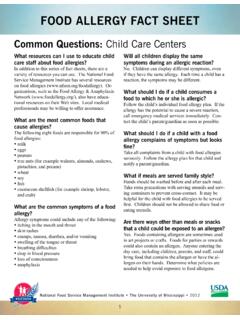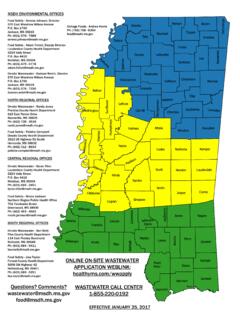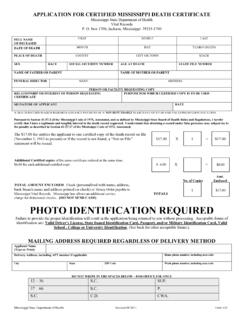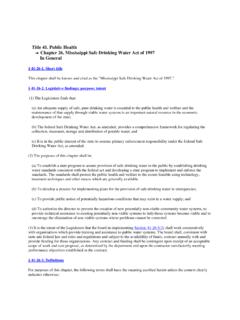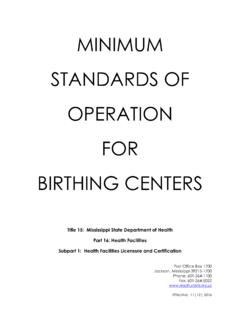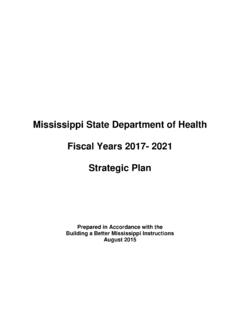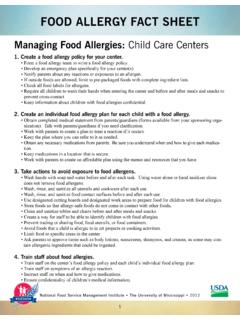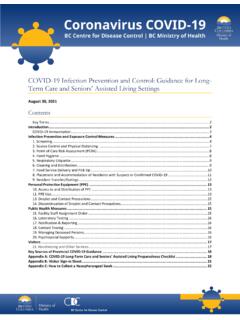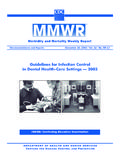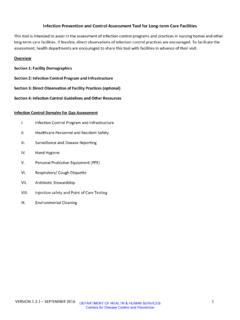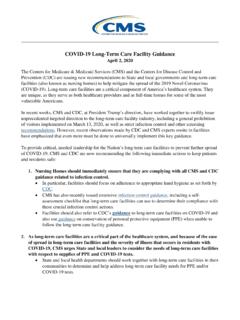Transcription of COVID-19 Prevention and Response Activities in Long-term ...
1 September 2021 1 COVID-19 Prevention and Response Activities in Long-term care /Residential care Facilities Resources from the Centers for Disease control and Prevention for Nursing Homes and long - term care Facilities: Infection Prevention and control Recommendations to Prevent SARS-CoV-2 Spread in Nursing Homes and Testing Guidelines for Nursing Homes: ncov/ SARS-COV-2 Antigen Testing in long Term care Facilities: Considerations for Memory care Units in Long-term care Facilities: Infection control Assessment Tool: ncov/ Updated Healthcare Infection Prevention and control Recommendations in Response to COVID-19 Vaccination: Long-term care Facility Toolkit: Preparing for COVID-19 Vaccination at Your Facility: MSDH COVID-19 Vaccination Provider Enrollment, Vaccine Request, and Resources: ,0,71, Monoclonal Antibodies Strongly Recommended in Long-term care Facilities: Monoclonal Antibody Update for COVID-19 : Subcutaneous Use and Emergency Use Authorization for Post-Exposure Prophylaxis ( ) Updated Guidance for an Additional Dose or Third Dose of mRNA COVID-19 Vaccine for Immunocompromised Individuals COVID-19 Prevention Activities The following Mississippi State Department of Health (MSDH) guidance is intended to supplement the CDC Infection Prevention and control Recommendations to Prevent SARS-CoV-2 Spread in Nursing Homes ( ncov/ ) and the Interim Infection Prevention and control Recommendations for Healthcare Personnel During the Coronavirus Disease 2019 ( COVID-19 ) Pandemic (Infection control .)
2 Severe acute respiratory syndrome coronavirus 2 (SARS-CoV-2) | CDC). Please refer to those documents for all recommendations not specifically covered in the MSDH specific general guidance for nursing homes and other Long-term care facilities. Please also see visitation guidelines for nursing homes and all other facility types on the MSDH COVID-19 website. Assign one or more individuals with training in infection control to provide on-site management of the facility s Infection Prevention and control (IPC) Program. CDC s Nursing Home Infection Preventionist Training Course is available for free CE online and can September 2021 2 aid in orienting individuals to this role in nursing homes. Actively screen and establish a process to identify all persons entering the facility, regardless of their vaccination status, who have any of the following so that they can be properly managed: a positive viral test for SARS-CoV-2, symptoms of COVID-19 , or who meets criteria for quarantine or exclusion from work.
3 Implement sick policies to encourage staff to stay home when ill. Assess the current supply of personal protective equipment (PPE) and initiate measures to optimize current supply. All staff should wear appropriate PPE when they are interacting with residents, based on levels of community transmission in the county, found at CDC COVID Data Tracker. In general, fully vaccinated HCP should continue to wear source control while at work; however, there are a few situations where fully vaccinated HCP who do not have other indications for source control could choose not to wear source control . Fully vaccinated HCP in counties with low to moderate community transmission may choose to not wear source control or physically distance themselves while dining/socializing together or attending in-person meetings, but only in well-defined areas that are restricted from patient access ( , break rooms).
4 If unvaccinated HCP are present, everyone should wear source control and unvaccinated HCP should physically distance from others. Encourage all eligible residents and staff to become fully vaccinated with an approved COVID-19 vaccine when feasible. Implement a plan for ensuring access to COVID-19 vaccination to new residents and new employees Coordinate with a local pharmacy to provide COVID-19 vaccine, or Consider enrolling as a COVID-19 vaccination provider to obtain vaccine from MSDH. Develop a process for identifying immunocompromised individuals (resident/staff) that should receive an additional dose of an mRNA COVID-19 vaccine per current CDC recommendations. Develop a plan now to be able to vaccinate residents and staff with a COVID-19 booster according the most to current FDA and CDC recommendations. Create a Plan for Routine Testing of HCP for SARS-CoV-2 (based on levels of community transmission within the county, found at CDC COVID Data Tracker).
5 Expanded screening testing of asymptomatic HCP should be as follows: Fully vaccinated HCP may be exempt from expanded screening testing. Unvaccinated HCP should have a viral test twice a week when county COVID-19 level of community transmission is substantial to high Unvaccinated HCP should have a viral test weekly when county COVID-19 level of community transmission is moderate. Regardless of the level of community transmission within a county, MSDH requires all healthcare workers, staff and employees* of Mississippi nursing homes and assisted living facilities are required to be fully vaccinated against COVID-19 * or receive COVID-19 testing two times weekly. ( ) Testing is not recommended for people who have had SARS-CoV-2 infection in the last 90 days if they remain asymptomatic. September 2021 3 Coordinate with the facility medical director to determine if/when monoclonal antibody therapy (REGEN-COV, Bam/Ete or Sotrovimab) should be initiated in your facility to prevent hospitalizations and deaths.
6 Monoclonal antibodies are recommended for both treatment of infected individuals and post-exposure prophylaxis (REGEN-COV and Bam/Ete products) of unvaccinated residents who are contacts to COVID-19 infected persons and at high risk of developing complications. Facilities are strongly encouraged to develop a system of administration of monoclonal antibodies within their facilities. For more information, see Referral Information for Monoclonal Antibody Treatment ( COVID-19 Centers of Excellence) - Mississippi State Department of Health ( ). See EUAs for each at Fact Sheet For Health care Providers Emergency Use Authorization (Eua) Of Bamlanivimab And Etesevimab 09162021 ( ) and Regeneron EUA HCP Fact Sheet 09172021 ( ) All facilities should actively screen each resident daily for symptoms consistent with infection, even if the facility is not currently experiencing cases among employees or residents.
7 Long-term care residents may not present with typical symptoms of fever or respiratory symptoms. Cases have been identified in residents with minimal cough, low grade fever (< oF), dizziness, diarrhea, sore throat or altered mental status. Have a high index of suspicion and utilize pulse oximetry in active screening. Diminished oxygen saturation has often been the first sign of infection among nursing home residents. Source control and physical distancing (when physical distancing is feasible and will not interfere with provision of care ) is recommended for everyone in the facility. The safest practice is for residents and visitors wear a well-fit ting cloth mask or facemask and physically distance. If the patient and all their visitor(s) are fully vaccinated, they can choose not to wear source control and to have physical contact.
8 Visitors should wear source control when around other residents or HCP, regardless of vaccination status. Dedicate space in the facility for cohorting and managing care for residents with COVID-19 Follow current CDC guidance for New Admissions and Residents who Leave the Facility Follow current CMS COVID-19 Visitation Guidelines for Nursing Homes If COVID-19 is identified in the facility or an outbreak is suspected Notify the MSDH Office of Epidemiology (601-576-7725 or 601-576-7400 after hours) of any identified COVID-19 infection in a resident or employee within the facility. Outbreak definition: COVID-19 infection confirmed in a single resident or employee An outbreak should be suspected when clusters of respiratory disease ( 3 residents and/or staff) are identified. Notify the MSDH Office of Epidemiology of any confirmed or suspected outbreak.
9 Below are some first steps to begin when contacting MSDH. Response to a newly identified SARS-CoV-2- infected HCP or Resident Because of the risk of unrecognized infection among residents, a single new case of SARS-CoV-2 infection in any HCP or a nursing home-onset SARS-CoV-2 infection in a resident should be evaluated as a potential outbreak. Consider increasing monitoring of all residents from daily to every shift, to detect more rapidly those with new symptoms. September 2021 4 HCP and residents with symptoms of COVID-19 : o Symptomatic HCP, regardless of vaccination status, should be restricted from work pending evaluation for SARS-CoV-2 infection. o Symptomatic residents, regardless of vaccination status, should be restricted to their rooms and cared for by HCP using a NIOSH-approved N95 or equivalent or higher-level respirator, eye protection (goggles or a face shield that covers the front and sides of the face) gloves, and a gown pending evaluation for SARS-CoV-2 infection.
10 Managing residents who had close contact with someone with SARS-CoV-2 o Unvaccinated residents who have had close contact with someone with SARS-CoV-2 infection should be placed in quarantine for 14 days after their exposure, even if viral testing is negative. HCP caring for them should use full PPE (gowns, gloves, eye protection, and N95 or higher-level respirator). Although not preferred for healthcare settings, options for shortening quarantine are available. o Fully vaccinated residents who have had close contact with someone with SARS-CoV-2 infection should wear source control and be tested as described in the testing section. o Fully vaccinated residents and residents with SARS-CoV-2 infection in the last 90 days do not need to be quarantined, restricted to their room, or cared for by HCP using the full PPE recommended for the care of a resident with SARS-CoV-2 infection unless they develop symptoms of COVID-19 or are diagnosed with SARS-CoV-2 infection.
